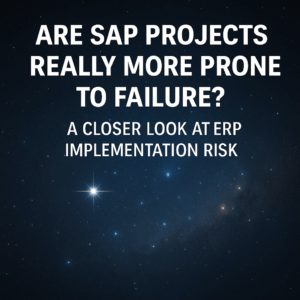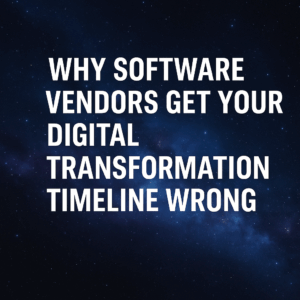Trends in the ERP software space are a lot like politics. One minute a certain political party is firmly in control – then a few years later things change, and a new party is in control. With each shift comes hope and promise that the not-so-new answer will solve the problems of the “old” way of thinking. And so, the cycle continues like a pendulum.
Table of Contents
ToggleCommon pendulum swings in the ERP software industry
The same is true for ERP implementations. Whether it’s on premise vs. cloud, single ERP vs. best of breed, Tier I ERP software vs. Tier II, or other myriads of decisions that need to be made, what works well today isn’t necessarily what will work tomorrow. But what goes out of style tomorrow may indeed be the flavor of the month again in a few years.
In the quest for the holy grail of ERP implementation success, ERP vendors, systems integrators, and their customers keep throwing spaghetti at the wall to see what sticks. For example, while SAP struggles to overcome failures at Revlon, Lidl, and Haribo, it is promoting agile within its S/4HANA Activate methodology as the solution. Surely, something will help us get out of this rut of constant ERP implementation failure – right?
Agile ERP software implementations: the new flavor of the month
The agile vs. waterfall discussion is no different. Big, bloated, expensive, and failed ERP implementations are a problem that need to be fixed. In the quest to solve this problem, the industry thinks it has found the answer: “agile” implementations.
Rather than taking a ton of time and money implementing a big, cross-functional, and integrated system, agile promises a faster and more nimble approach. Implementations will be cheaper, less money will be spent, and everyone will be happy! It also aligns well with the lean startup movement and other flavors of the month that focus on nimble, agile, and flexible business models.
The video below whiteboards how the SAP and ERP industry is spinning its messaging to customers via brute force, including agile:
ERP = “enterprise,” not bits and pieces of the enterprise
In many ways, agile ERP implementations defeat the purpose of ERP. The intended value proposition for most ERP-based digital transformations is the ability to integrate and standardize business operations across an organization. Agile by its very nature, on the other hand, looks for smaller quick wins that may or may not tie into an overarching and longer-term digital strategy.
Agile is an excuse for ERP vendors to get a foot in the door
For ERP vendors and its system integrators, agile is a brilliant marketing move. They are jumping on this bandwagon to give executive and project teams cover to just select their ERP solution on a small scale (along with a systems integrator), which provides the all-important foot in the door. In other words, it helps vendors sell that smaller entry point, and since ERP switching costs are so high, they know that it is highly likely that the rest of the organization will eventually adopt the software too.
Agile masks – and in many cases, propagates – the real root cause of transformation failure: misalignment
“Quick win” agile transformations allow functional areas or individual locations to get started on something right away, but it doesn’t fix the underlying issue of organizational misalignment, which is the real cause of digital transformation failure. For example, if your finance team decides to implement the “digital core” of SAP S/4HANA’s financial modules, this may or may not align with the needs of the rest of the organization.
So rather than fixing the underlying problem, agile transformations just put a band-aid on it and punt the problem into the future. If anything, agile makes the problem worse because it gives silos in the organization cover to dig in their heels to focus on their own needs rather than the needs of the overall organization.
Waterfall is the scapegoat for ERP implementation failure
Recent years have seen an SAP failure at Revlon, Hertz filed a lawsuit against Accenture for its digital transformation failure, and National Grid sued Wipro. There are too many examples to list them all here, but the common theme is that these big projects got out of control, cost too much, and delivered too little value at the end of the day.
Since we need someone or something to blame, one option is to blame the traditional waterfall approach to software development. And it makes sense in theory: if the projects are too big and expensive, then make them smaller! This is where agile enters the picture.
But, we all know that some of the real underlying problems with ERP implementations include:
- Misalignment within the organization
- Resistance to change
- Difficulty changing processes
- Getting “Accentured” by one of the big ERP systems integrators
- Poor ERP project management
- Poor executive leadership and sponsorship
- Immature technologies
- Lack of overall digital strategy
- Economic biases and influences that lead to poor decision-making throughout the ERP implementation
This by no means a complete list, but even when you look at our study of top 20 lessons from over 1,000 ERP implementations, waterfall methodology is not one of those top keys to success vs. failure.
Where agile ERP implementations do make sense
Although agile may be a current flavor of the month – and it is not a one-size-fits-all solution – there are instances where it does make sense. While it may not make sense for a large company that values efficiency, scale, and a consistent customer experience, there are other cases where it can work well. For example, smaller, more entrepreneurial companies that are more concerned with speed than they are with efficiency can often benefit from agile digital transformations.
But here is the problem: vendors and systems integrators offer too much bias and too little objectivity for their customers to make clear-headed decisions. This is one of the fatal flaws in the digital transformation and ERP software industry.
Conclusion: Define the digital strategy that makes the most sense for your organization
Agile may sound cool, but it is often times not. Instead of looking for that silver bullet that might fix the symptoms of the problem, it’s more important to address the root cause. This begins with defining the best digital strategy for your organization based on your strategy and objectives. This may or may not result in an agile implementation.
Please contact me if you would like to brainstorm ideas of how to make key decisions related to your digital transformation. I am happy to be a sounding board as you continue your digital transformation journey!





